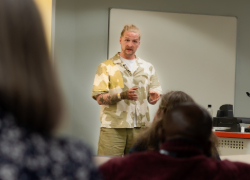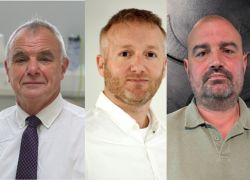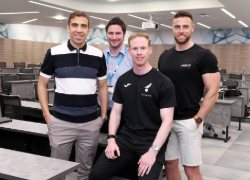Forensic breakthrough cements Teesside University’s place as a founding father of forensic science
Researchers reach “holy grail” of blood stain examination as Teesside celebrates 21 years as a founding father of forensic science and crime scene degrees.
• hyperspectral imaging set to revolutionise the detection and age estimation of blood at crime scenes • breakthrough means errors in high profile cases such as Stephen Lawrence and Damilola Taylor could be a thing of the past • experts to present their research at an international conference which coincides with Teesside University’s 21st anniversary of teaching forensic science • crime author Val McDermid, best known for Wire in the Blood, on board to join celebrations at Teesside – the first University in the country to offer forensic and crime scene courses • the success of forensic science at Teesside has brought international acclaim and placed graduates in high profile jobs all over the world.
The failure to locate traces of blood during the original forensic examinations meant that the killers of both Stephen Lawrence and Damilola Taylor evaded justice. It was only years later when the forensic evidence was reviewed that traces of blood were identified and the killers were eventually brought to justice. Now, researchers at Teesside University are set to revolutionise forensic science with a high-tech blood detection technique which will help investigators avoid these mistakes in the future.
The team of experts at Teesside University have come up with a unique method of not only detecting and identifying blood at crime scenes, but also accurately estimating its age.
Visible wavelength hyperspectral imaging allows for the positive identification of blood which may be confused with other red coloured substances, hard to see on dark backgrounds or not visible to the naked eye. It also enables investigators to pinpoint the age of a one month old blood stain to within one day – something that has so far eluded forensic scientists.
Dr Meez Islam, a physical chemist and Reader in the University’s School of Science & Engineering, is one of the academics behind the forensic breakthrough, which also involved his colleagues Liam O'Hare, Peter Beveridge and the work of their PhD student Bo Li.
He said: 'Often you go to crime scenes and what appears to be blood isn’t blood. Blood on dark backgrounds can be hard to see and there are traces of blood that are not visible to the naked eye. Current tests use chemicals which can be detrimental to the subsequent DNA analysis of the blood stain. There have also been cases where investigators have completely missed blood stains – either at the crime scene or on items of clothing.'
'We have developed a hyperspectral imaging technique which is a non-contact, non-destructive way of detecting and identifying blood. We use a camera with a liquid crystal tuneable filter which takes a series of pictures at different wavelength bands and can identify blood stains through its unique absorption spectrum.' 'It can quickly differentiate between what is blood and what isn’t and it can locate blood stains on problematic areas such as red clothing or dark backgrounds and at diluted amounts. What this does is provide fast, at the scene identification of blood and speeds up the investigative process as items do not need to go back to a laboratory to be examined. To use hyperspectral imaging in a way that scans the crime scene for blood also means that the chances of missing a bloodstain are vastly reduced.'
Dr Islam and his team currently have a prototype instrument and are already in talks with forensic instrument manufacturers about developing a commercial instrument whilst Police Forces have expressed interest in using hyperspectral imaging for blood stain detection. The researchers plan to make a portable device that can be used both at the crime scene and in a laboratory.
Another “game-changing” development of hyperspectral imaging is that it can estimate the age of a blood stain – something that Meez described as one of the “holy grails” of forensic science. Blood stains change from bright red to a dark reddy brown as they age, hyperspectral reflectance imaging and spectral pre-processing can use that colour change to determine the age of blood stains.
'Current methods for age determination of blood stains are neither accurate, reliable, robust nor useable at a crime scene,' explained Dr Islam.
'Our method is able to accurately estimate the age of a one month old blood stain to within a day under controlled conditions. It is potentially a huge step forward for forensic science. Again it speeds up the investigative process as you are able to quickly estimate how old a blood stain is.
'At crime scenes blood stains can be from different time periods. Our technique can distinguish between overlapping blood splatter patterns of different ages and could be used to determine the timeline for a violent crime.'
'We need to do more experiments to understand the effect of environmental factors such as temperature and humidity on the ageing process but we are confident that we will be able to account for these effects. We hope to produce a single instrument which will be able to both detect blood stains and also estimate their age.'
Meez and his team will present their latest hyperspectral imaging research on blood stains at the Forensic Science Society Research and Development Conference, to be held in Manchester from 6 to 8 November.
Teesside University to celebrate 21 years of forensic science Teesside University is a founding father of forensic science and the first University in the country to offer forensic and crime scene courses.
To mark the 21st anniversary of forensics at Teesside, a special celebratory event is taking place at the University on Thursday 7 November.
‘Forensic science – past, present and future’ will reflect on past achievements and look forward to new developments in this highly specialised field.
Bestselling crime writer Val McDermid, famous for her Wire in the Blood series, will be the guest of honour and will talk about how scientific fact is now informing fiction.
Brian Rankin, Head of the Centre for Forensic Investigation at Teesside, said: 'Teesside University is leading the way in forensic science – not only in the courses we provide, but in the research we are carrying out. Our reputation as a leader in the forensics field is firmly established.
'Twenty-one years ago nobody was teaching forensics and crime scene courses. To look back on all that we have achieved and to know we were the first university to offer such courses is something worth celebrating.'
What makes Teesside so special? • Teesside University has close links with the Home Office Centre for Applied Science and Technology, the Metropolitan Police, forensic science providers and the College of Policing. Courses are supported by a crime scene house laboratory, a digital evidence laboratory and a vehicle examination laboratory. Further laboratories are equipped with a full range of optical microscopes, chemical analysis equipment and a DNA suite. It also offers a mock court room which can simulate family, crown or magistrates' court hearings.
• Teesside University has worked with the Quality Assurance Agency for Higher Education to produce nation guidance on how forensic science degrees should be taught.
• Forensic and crime scene graduates are working in prestigious jobs all over the world, including Qatar, Germany and Australia.
• Dr Tim Thompson, a Reader in Biological & Forensic Anthropology, is one of the University’s leading forensic experts. His unique methods for bone identification have attracted national interest.
• Several Teesside University lecturers sit on National standard setting groups with the Forensic Science Regulator, United Kingdom Accreditation Service and Skills of Justice.
 Teesside University raising aspirations for young people in
...
Teesside University raising aspirations for young people in
... Teesside University awards Honorary Doctorates to industry
...
Teesside University awards Honorary Doctorates to industry
... Alumni support elite football event
Alumni support elite football event